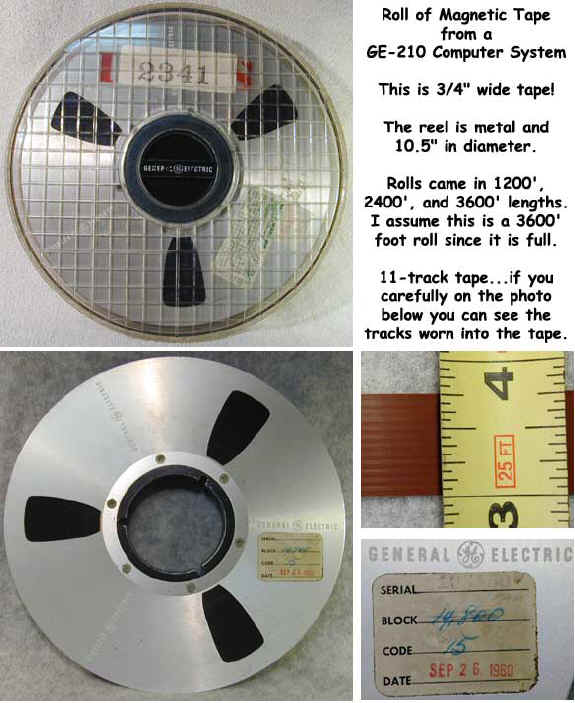|
The GE-200 product originated in the early days of the Computer Department in Phoenix AZ. In fact, the GE-200 name has been also used for banking products derived from the first GE computer, the ERMA project, General Electric marketed in the early 60s the GE200 Bank Transit system around a document (check) sorting system. Three variations of the same central processor constitutes that product line sold between 1959 ? and 1966. GE-225 The GE-225 was derived from the GE-312 and 412 Process control computers, then part of the Computer Department products. It was designed by Arnold Spielberg and Chuck Prosper, ex-RCA engineers who have been working on BIZMAC. It was introduced in 1960.
The GE-225 was a 20-bits word binary machine with
3 hardware registers not specially designed for business applications. Addition was performed in 36 µs. Multiplication in 288 µs and Division in 495µs Technology was solid-state (diodes and transistors). A 8K words system contained 1,000 circuit boards, 10,000 transistors, 20,000 diodes and 186,000 magnetic cores.The power dissipation was 16 KVA. Main memory was offered in 4, 8 and 16K words.Its access time was 18 µs. Peripherals included: Up to 11 devices may operate simultaneously, through independent channels connected to the memory by an autonomous "controller selector". Unit record devices operated under processor control. Software includes a compiler of GECOM language (a COBOL dialect with many ALGOL features), TABSOL (a language based on decision tables), WIZ (a Algebraic compiler), FORTRAN II, GAP a translator for IBM 650 and LGP30 and a Report Generator. Charlie Bachmann develops the IDS data base system for the GE-225 before it was ported to GE-400 and GE-600 One of the major initial customers was at Huntsville Arsenal, a NASA predecessor) The GE-215 was a scaled-down version of the GE-225. The number of channels was reduced to 6.The main core memory was limited to 4K and 8K words. Addition was performed in 72 µs. Multiplication in 342 µs and Division in 531 µs The GE-235 was a re-implementation (three times faster) of the GE-225 with a faster memory (cycle 5 µs) designed in 1962 and delivered in 1964. Addition was performed in 12 µs.
Multiplication in 84 µs and Division in 85 µs, thanks to a new
high-speed arithmetic unit.
The GE-265 that was the system running the first commercial time-sharing system is the association of a GE-235 processor and of a Datanet-30 communication processor. The software was designed at Dartmouth College as DTSS in 1963-1964.While BASIC was the main programming language created for that system, it was also used in ALGOL and Fortran. A peculiarity of the DTSS was that the main part of the operating system was resident in the DN-30 front-end processor and that only the user programs and their environment (e.g.the BASIC interpreter) were executed in the GE-235. The two processors were interconnected through a direct interface and were sharing a disc unit DS-20. A contemporary (1964) description of the system will be available here This system was introduced by GE and by Bull-General Electric in 1965
The GE-265 operating system was renamed Mark I and was later (1968) ported on GE-635 as Mark II and Mark III, by General Electric Information Services Division that was not transferred to Honeywell in 1970
Note: The ERMA machine developed for the Bank of America and NCR (NCR 304) has got also the name of GE-210 when sold to other banks than BofA, and GE-304B when used internally at General Electric. It is not part of "Compatibles GE-200."
|
| Copyright © 1999 [Fédération des Equipes Bull]. Tous droits réservés. Revision : 04 décembre 2002 |
|
DARTMOUTH TREASURES AT THE SMECC
Treasured parts of Dartmouth Basic GE Timeshare System come to SMECC Several years ago a teacher had a variety of computer artifacts on display in his classroom—including many different examples of core memory and portions of a GE-210 system. The GE-210 computer was originally installed at Dartmouth College in 1962 and later bought by Pillsbury Corp. in Minneapolis and used as part of their time-sharing system. This collection consists of (1) a core memory plane from the original stack, (2) the instruction manual for the memory unit, and (3) a printed circuit board from the unit. The core memory plane is a fantastic example of core memory. The cores are huge and the plane is actually strung on both sides. Each side contains a 42 x 50 array for a combined array of 84 x 50 and a total of 4200 cores. There were 28 planes in the original stack that provided a 4000 word (28 bit) memory. The manual is in a 3-ring binder and contains a 309 page manual published by Ampex Computer Products Co. (1961 copyright) and Telemeter Magnetics, Inc. (1959 copyright). I assume these two companies together made this unit. The sections in the manual include: General Description, Installation, Operation, Principles of Operation, Troubleshooting, Drawings, and a couple Addendums. The printed circuit board contains transistors and measures 3.5” by 8”.
|

Several years ago a teacher had a variety of computer artifacts on display in his classroom—including portions of GE-210 computer system that was originally installed at Dartmouth College in the early 1960’s and later bought by Pillsbury in Minneapolis. In the archive here is a roll of magnetic tape from this system along with the plastic storage case. This tape was not very standard. It was ľ” wide and had 11 tracks—where most systems used ˝” tape with either 7 or 9 tracks. Rolls came in lengths of 1200 feet, 2400 feet, and 3600 feet. I assume this is a 3600 foot roll since the reel is full. The reel is metal and the tape is dated Sept. 26, 1960. It was cleaned in 1971.
|



